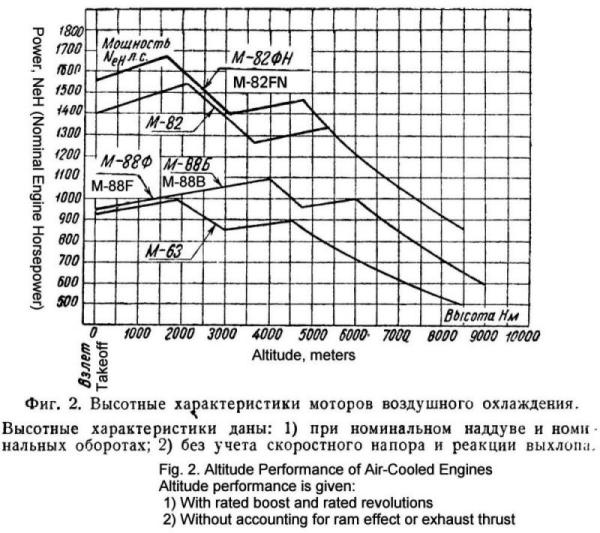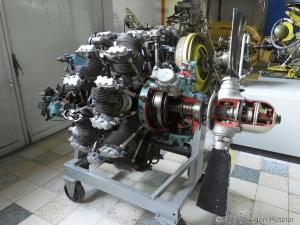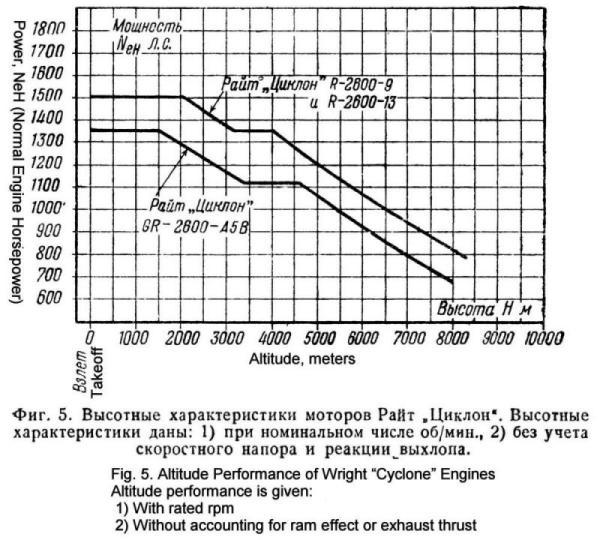Some Shvetsov Aircraft Engines
Comparing Selected Shvetsov and Wright Aeronautical Engines
Compiled by Dan Zamansky (Dan) and Kimble D. McCutcheon (Kim)
Published 8 April 2020

Shvetsov Family Tree (Wikipedia) |
Arkady Shvetsov (1892 - 1953, Moscow), a Soviet aircraft engine designer, was sent to the U.S. on two business trips in the 1930s. He recommended the purchase of the Wright Aeronautical R-1820 Cyclone engine, and a licence agreement for the R-1820-F3, which became the Soviet M-25, was signed in 1933. In 1934, Shvetsov was appointed chief of the design section at the Aircraft Engine Plant No. 19 in the town of Perm, northern Urals. This factory was built to mass produce the M-25 engine. In 1939, the design section was expanded into the OKB-19 design bureau, where Shvetsov continued to produce air-cooled radial aircraft engines derived from the Cyclone.
Dan Zamansky located and translated specifications for two Shvetsov engine families, the M-62 and M-82. These came from:
Aero Engine Reference Guide. Second edition, expanded and revised. General editor Engineer-Colonel M. P. Fokin. Directorate of the Red Army Air Forces. NKAP USSR [People’s Commissariat of the Aircraft Industry of the Union of Soviet Socialist Republics]. State Publishing House of the Defence Industry. Moscow, 1943. |
 |
| Shvetsov Engine Family Power Curves. Also included are curves for the Tumansky M-88 series, developed from the French Gnome et Rhône 14K Mistral Major |
Introduction
Dan initially provided basic specifications for the Shvetsov 9-cylinder M-62 and 14-cylinder M-82, along with three 14-cylinder Wright R-2600 series engines delivered to the USSR with Lend-Lease aircraft. The initial specifications included cylinder dimensions, compression ratio, supercharger low and high blower gear ratios, takeoff ratings and altitude ratings.
When comparing the M-82FN and R-2600-13, Dan wondered how, with a somewhat smaller displacement, lower rpm and lower manifold pressure, the M-82FN produced the same power and did so at an altitude more than 305m higher than the U.S. engine? Could this be explained with reference to basic engineering principles, or was it an example of Soviet performance inflation?
Kim selected two 9-cylinder Wright R-1820 models for comparison to the M-62 series. The R-1820 models had reduction gear ratios, compression ratios, supercharger gear ratios that were very nearly identical to their respective M-62 models. Again, there were curious differences between the U.S. and Soviet ratings, particularly with the direct drive engines.
These ponderings led to three questions:
1) How did the Soviet direct-drive engines turn so fast? Did they use very small-diameter propellers and accept the tip losses at high rpm?
2) How did the Soviet engines produce consistently more power than their U.S. counterparts? One clue was the consistently higher manifold pressure in Soviet engines. Could the Soviet engines be running larger-diameter supercharger impellers?
3) How did the specific fuel consumption of Soviet engines and their U.S. counterparts compare?
More data was needed. Dan found engine weights, along with representative propeller and supercharger impeller diameters. Dan noted that the impeller diameter is an interesting conundrum. It is only mentioned as a note on the difference between the ASh-82FN and the ASh-83 engines. Said difference is reported as a change from the 288 mm impeller of the ASh-82FN to a 305 mm impeller on the ASh-83. Could it be possible that the impeller diameter never changed in the entire M-25 through M-82 series of engines? A 288 mm impeller diameter was assumed for this exercise.
Kim introduced these new findings into the data tables, and derived brake mean effective pressure (bmep), propeller tip speed and supercharger impeller tip speed values that would allow further comparison. These results appear below.
The bmep (brake mean effective pressure in psi) values were calculated using the following formula:
bmep = (hp * 33000) / (L * A * N * K) where
hp = horsepower
L = piston stroke in feet
A = piston area in square inches
N = number of working cycles per revolution (rpm / 2)
K = number of cylinders
Shvetsov M-62
 |
| Shvetsov ASh62 (Gary Brossett) |
Shvetsov M-62 and Wright R-1820 Comparison
| Specification | M-62 | M-62IR | M-63 | R-1820-27 | R-1820-47 |
|---|
| Bore, mm | 155.5 | 155.5 | 155.5 | 155.575 | 155.575 |
| Stroke, mm | 174.5 | 174.5 | 174.5 | 174.625 | 174.625 |
| Displacement, L | 29.8 | 29.8 | 29.8 | 29.876 | 29.876 |
| Reduction Gear Ratio | 1:1 | 16:11 | 1:1 | 1:1 | 16:11 |
| Compression Ratio | 6.4±0.1 | 6.4±0.1 | 7.2±0.1 | 6.4 | 6.45 |
| Low Blower Gear Ratio | 7.14 | 7.00 | 7.14 | 7.14 | 7.00 |
| High Blower Gear Ratio | 10.00 | none | 10.00 | 10.00 | none |
| Impeller Diameter, mm | 288 | 288 | 288 | 254 | 279.4 |
| Max Low Blower Impeller Tip Speed, m/sec | 237 | 232 | 248 | 185 | 225 |
| Max High Blower Impeller Tip Speed, m/sec | 317 | | 332 | 259 | |
| Takeoff hp / rpm / mmHgA | 1,000 / 2,200 / 1,050±20 | 1,000 / 2,200 / 1,050±20 | 1,100 / 2,300 / 1,065±10 | 670 / 1,950 | 975 / 2,200 |
| Takeoff BMEP, psi | 198 | 198 | 208 | 149 | 184 |
| Takeoff Power Duration, min | 5 | 5 | 5 | | |
| Sea Level Low Blower Rated hp / rpm / mmHgA | 830 / 2,100 / 900±10 | 820 / 2,100 / 900±10 | 930 / 2,200 / 915±10 | 670 / 1,950 | 830 / 2,100 |
| Altitude Low Blower Rated hp @ meters |
850 @ 1,150 | 840 @ 1,500 | 1,000 @ 1,800 | | 850 @ 762 |
| Sea Level High Blower Rated hp / rpm / mmHgA | 700 / 2,100 / 900±10 | | 780 / 2,200 / 915±10 | | |
| Altitude High Blower Rated hp / rpm / meters |
800 / 2,100 / 4,200 | | 900 / 2,200 / 4,500 | 670 / 1,950 / 3,139 | |
| Dry Mass, kg | 490 | 560 | 515 | 476.3 | 534.3 |
| Takeoff Specific Power (hp/kg) | 2.04 | 1.79 | 2.14 | 1.41 | 1.74 |
| Representative Propeller | | VISh-21 | AV-1 / VV-1 | | Curtiss
55003D-2-3315285 |
| Representative Aircraft | Polikarpov I-153 | Lisunov Li-2 | Polikarpov I-16 type 29 | | Curtiss Y1A-18 |
| Propeller Diameter, m | 2.9 | 3.4 | 2.7 | | 3.35 |
| Propeller Takeoff Tip Speed, m/sec | 334 | 269 | 325 | | 265 |
| Maximum 30-sec Dive rpm | 2,500 | 2,500 | 2,500 | | |
| Minimum rpm | 500 | 500 | 500 | | |
| Fuel Grade* (Octane Rating) | 3B-74 (91) | 3B-74 (91) | B-95 (94-95); 3B-78 (93-94) | (87) | (91) |
* If necessary, M-62, M-62IR and M-63 engines
can be operated using 4B-70 grade fuel
with octane rating 89 |
Comments
Impeller Diameter, Max Low Blower and Max High Blower Impeller Tip Speed. While the Shvetsov supercharger impeller diameters are a bit larger than those from Wright, they are not unreasonably so. This larger impeller may also account for the higher manifold pressures that appear in the ratings. Impellers and their gear drives are typically selected to have tip speeds around the 265 m/sec, which all of these do. Larger diameters and higher tip speeds provide higher pressure, but they also take more power to drive and heat the induction charge more. Engine designers try to choose these parameters so that supercharger efficiency is maximized.
Shvetsov Takeoff BMEP values are higher than Wright's, but not unreasonably so. One can raise the power of any engine by increasing its bmep, but this ultimately impacts reliability. Soviet engines were indeed known to be less reliable, with a significantly lower service life, than Western designs. The caveat is that in Soviet service, Western engines were sometimes used with inferior Soviet gasoline and oil, which seriously decreased their service life, or at least their practical performance. It was a known phenomenon that younger pilots in units flying Lend-Lease fighters could be given aircraft with engines that had been damaged in this way, with the consequence that these pilots could not use their aircraft effectively in combat.
Propeller Diameter, Propeller Takeoff Tip Speed. The takeoff-rpm tip zero-airspeed tip speeds are all subsonic (<343 m/sec) and hence workable, if not ideal. Direct-drive models achieved this by using a relatively small propeller diameter. Calculated tip speeds are first-order standard-temperature approximations that ignore airspeed. In-flight values, whose calculation is much more involved, will be higher. Note the small diameter propeller tip speeds for the direct-drive M-62 and M-63 are very close to sonic, even at zero airspeed. This was probably a limiting operational factor.
Indeed, later "Brief Guidance for M-62 and M-63 Engine Operation" admonished,
To ensure reliable operation of the connecting rod sleeve, the take-off and nominal power ratings of the M-63 engines stated in the master data are limited to the following permissible limits:
a) take-off and nominal rpm lowered to n = 2100 revolutions/minute;
b) take-off boost lowered to 950 mmHg, nominal boost - to 850 mm Hg
Ratings. Detailed engine power charts would have been nice, but none were available for the engines under investigation. Kim tried to normalize the comparisons using takeoff power and rated (maximum continuous) power at altitude and two possible blower configurations. While these are potentially problematical metrics, they do offer reasonably good first-order comparisons.
Cruise Specific Fuel Consumption comparisons require the detailed charts that are unavailable. However, it is possible to compare rough cruise specific fuel consumption for all engines. The U.S. engines appear to be significantly better, which is possibly explained by more efficient propellers and superchargers.
Note: Although the R-1820-27 was chosen because it was the highest hp direct-drive engine with comparable compression and supercharger ratios, only two of these were ever built and they were probably never flown.
Several ASh62 variants have received U.S. FAA Type Certificates.
Shvetsov M-82
 |
| Shvetsov ASh82 (Eugen Peteler) |
Shvetsov M-82 and Wright R-2600 Comparison
| Specification | M-82-112 | M-82-212 | M-882FN | GR-2600-A5B | R-2600-9 | R-2600-13 |
|---|
| Bore, mm | 155.5 | 155.5 | 155.5 | 155.575 | 155.575 | 155.575 |
| Stroke, mm | 155.0 | 150.0 | 155.0 | 160.3375 | 160.3375 | 160.3375 |
| Displacement, L | 41.2 | 41.2 | 41.2 | 42.671 | 42.671 | 42.671 |
| Reduction Gear Ratio | 11:16 | 9:16 | 11:16 | 9:16 | 9:16 | 9:16 |
| Compression Ratio | 7.0±0.1 | 7.0±0.1 | 7.0±0.1 | 6.3 | 6.9 | 6.9 |
| Low Blower Gear Ratio | 7.14 | 7.14 | 7.14 | 7.14 | 7.06 | 7.06 |
| High Blower Gear Ratio | 10.00 | 10.00 | 10.00 | 10.00 | 10.06 | 10.06 |
| Impeller Diameter, mm | 288 | 288 | 288 | 279.4 | 279.4 | 279.4 |
| Max Low Blower Impeller Tip Speed, m/sec | 258 | 258 | 269 | 251 | 269 | 269 |
| Max High Blower Impeller Tip Speed, m/sec | 362 | 362 | 362 | 351 | 353 | 353 |
| Takeoff hp / rpm / mmHgA | 1,700 / 2,400 / 1,140±10 | 1,700 / 2,400 / 1,140±10 | 1,850 / 2,500 / 1,180±10 | 1,600 / 2,400 / 1,143 | 1,700 / 2,600 / 1,118 | 1,700 / 2,600 / 1,118 |
| Takeoff BMEP | 223 | 223 | 233 | 203 | 199 | 199 |
| Takeoff Power Maximum Duration, min | 10 | 10 | 10 | 5 | 5 | 5 |
| Sea Level Low Blower Rated hp / rpm / mmHgA | 1,400 / 2,400 / 950±10 | 1,400 / 2,400 / 950±10 | 1,570 / 2,400 / 1,000±10 | 1,350 / 2,300 / 978 | 1,500 / 2,400 / 1,016 | 1,500 / 2,400 / 1,016 |
| Altitude Low Blower Rated hp / rpm / meters | 1,540 / 2,400 / 2,050 | 1,540 / 2,400 / 2,050 | 1,670 / 2,400 / 1,550 | 1,1,600 /2,400 / 8,992 | 1,500 / 2,400 / 2,042 | 1,500 / 2,400 / 2,042 |
| Sea Level High Blower Rated hp / rpm / mmHgA | 1,100 / 2,400 / 950±10 | 1,100 / 2,400 / 950±10 |
1,255 / 2,400 / 1,000±10 | | | |
| Altitude High Blower Rated hp / rpm / meters | 1,330 / 2,400 / 5,400 | 1,330 / 2,400 / 5,400 | 1,460 / 2,400 / 4,600 | 1,600 / 2,400 / 8,992 | 1,350 / 2,400 / 3,962 | 1,350 / 2,400 / 3,962 |
| Dry Mass, kg | 850 | 850 | 900 | 884.5 | 898.1 | 898.1 |
| Takeoff Specific Power (hp/kg) | 2.00 | 2.00 | 2.06 | 1.81 | 1.89 | 1.89 |
| Cruise Specific Fuel Consumption (g/hp/hr) | >239 | >239 | >239 | >204 | >204 | >204 |
| Representative Propeller | VISh-105V | AB-5-167A | VISh-105V4 | Hamilton Standard | Hamilton Standard
23E50-241-1659A-18 | Hamilton Standard
23E50-241-1659A-18 |
| Representative Aircraft | Lavochkin La-5 | Tupolev Tu-2 (early) | Lavochkin La-7 | Douglas DB-7B | NAA B-25B | Douglan A-24C |
| Propeller Diameter, m | 3.1 | 3.8 | 3.1 | 3.43 | 3.84 | 3.84 |
| Propeller Takeoff Tip Speed, m/sec | 268 | 269 | 279 | 242 | 294 | 294 |
| Maximum 30-sec Dive rpm | 2,600 | 2,600 | 2,600 | 2,760 | 2,880 | 2,880 |
| Minimum rpm | 500 | 500 | 500 | 500 | 500 | 500 |
| Fuel Grade (Octane Rating) | 4B-78 (95) | 4B-78 (95) | 4B-78 (95) | B-95 (93), 2B-78 (91),
3B-74 (91) | B-100 (97), 4B-78 (95) | B-100 (97), 4B-78 (95) |
Comments
The above table compares Soviet-built M-82 engines with Wright engines acquired on aircraft delivered through the U.S. Lend-Lease Program. The Soviets would often complain that they received few spare engines, so the primary source of engines was from the aircraft themselves.
The M-82FN was a fuel injected engine; the letter F in the designation stands for 'boosted' and N for 'direct injection'.
All Max High Blower Impeller Tip Speed values exceed the speed of sound. Although the ratings suggest this was acceptable, it is doubtful such high tip speeds were tolerated during operation as they would have impacted pumping efficiency and caused excessive induction charge heating.
Shvetsov Takeoff BMEP values are higher than Wright's, but not unreasonably so. Shvetsov probably traded power for reliability. A Shvetsov engine, especially of the M-82 series, had a practical operational life of about 100 hours, so that is a possible way of quantifying inferior reliability. The M-82FN also had persistent reliability problems with the fuel injection system.
Cruise Specific Fuel Consumption comparisons require the detailed charts that are unavailable. However, it is possible to compare rough cruise specific fuel consumption for all engines. The U.S. engines appear to be significantly better, which is possibly explained by more efficient propellers and superchargers.
Note: The GR-2600-A5B specifications appearing in Aero Engine Reference Guide differ from those in the USAF and Wright R-2600-19 engine references. This is curious as all others are the same.
 |
| Wright R-2600 Power Curves |
Conclusion
This exercise has attempted to draw conclusions from sparse data, an endeavor always filled with risk. Readers who can provide additional data or insight are encouraged to email the AEHS via the webmstr address below.




